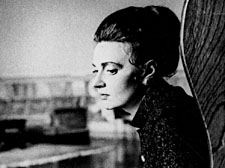|
|
 |
| |
A serious search for what made the authentic Muriel Spark tick
John Horder remembers the elusive novelist as literary bag lady and as the toast of New York
Muriel Spark: The Biography.
By Martin Stannard. Weidenfeld & Nicholson £25
THE conclusion by the end of Martin Stannard’s 627 unyielding pages of Muriel Spark’s biography is that most of us mistake surface appearances for reality for most of our lives. Because after all of his efforts, we are no nearer to the truth of what makes Muriel tick than we were when she died in Tuscany in 2006 in the house she shared with the artist Penelope Jardine.
The nearest she came to a lasting relationship was the nine years she lived and loved Derek Stanford, the poet and author of more than 30 books, including one about her, which was flawed by his habitual niggling mistakes.
This was after her unhappy marriage to the mentally unstable Solly (or Ossie) Spark had ended in divorce in Southern Rhodesia in I944.
There was a son who, surprise surprise, Muriel has never stopped brutally confronting, including from beyond the grave. Remarkably, he survives her.
The confrontations with everybody she imagined tried to do her down continued when the underfed and Dexedrine-popping Muriel weighed down by the deepest resentments wrote industrial speeches for my father, Pearson Horder – an early exponent of the art of public relations. This was after she had picked up some of the secrets of espionage while working for the propagandist and journalist Sefton Delmer, at the Foreign Office, before he joined the Daily Express.
I can remember when she came to my father’s office at 6 Queen Anne’s Gate, wearing a Victorian tea cosy instead of a hat, ghastly woollen stockings, and laden with the complete works of the Brontë sisters and her much-loved Cardinal Newman, whom she had already turned into a saint without any help from the Pope.
She could have claimed to be the first literary bag lady before Elizabeth Jennings, the poet, assumed this much sought-after role.
Muriel’s first big breakthrough came after she had converted to Roman Catholicism, and had published her first novel, The Comforters.
She was recognisably the pill-popping Caroline Rose who, like Evelyn Waugh, heard voices. It received a one-page rave review in the Spectator by that unhugged author of Vile Bodies.
Her 50-year vendetta against Derek Stanford resulted in her maliciously calling him “le pisseur de copie” – a writer with a tendency to verbosity – throughout her second breakthrough novel, A Far Cry to Kensington.
But the greatest transformation was when she moved from Camberwell to New York, and achieved the status of international celebrity over night, sparing no expense in buying the most expensive clothes and style of life that money could buy.
Everything appeared to be going swimmingly well on the surface. The Prime of Miss Jean Brodie in its entirety had occupied a single issue of the New Yorker, and she had even been given her own office by its editor, William Shawn.
But as Professor Stannard poignantly points out, her whole life got sucked into a never-ending and horribly exhausting diary of meetings with celebrities, and her mental and physical health went rapidly downhill.
The authentic Muriel will continue to elude you, as it has done Professor Stannard, by the end of this marathon.
The Prime of Miss Jean Brodie was the only novel with real love running right the way through it.
Her very last novella, The Finishing School, was a delight and a soufflé, ending with a gay marriage in prospect between the orange-haired young man and his teacher.
Muriel’s story was nearer Rumpelstiltskin’s than that of Cinderella’s rags-to-riches tale.
Perhaps, like the Emperor in The Emperor’s New Clothes, she really was wearing no authentic clothes throughout her life. And that what we perceived was her life was in reality only one more illusion of her own making.
JOHN HORDER |
 |
|
|
 |
 |
|
 |
|


